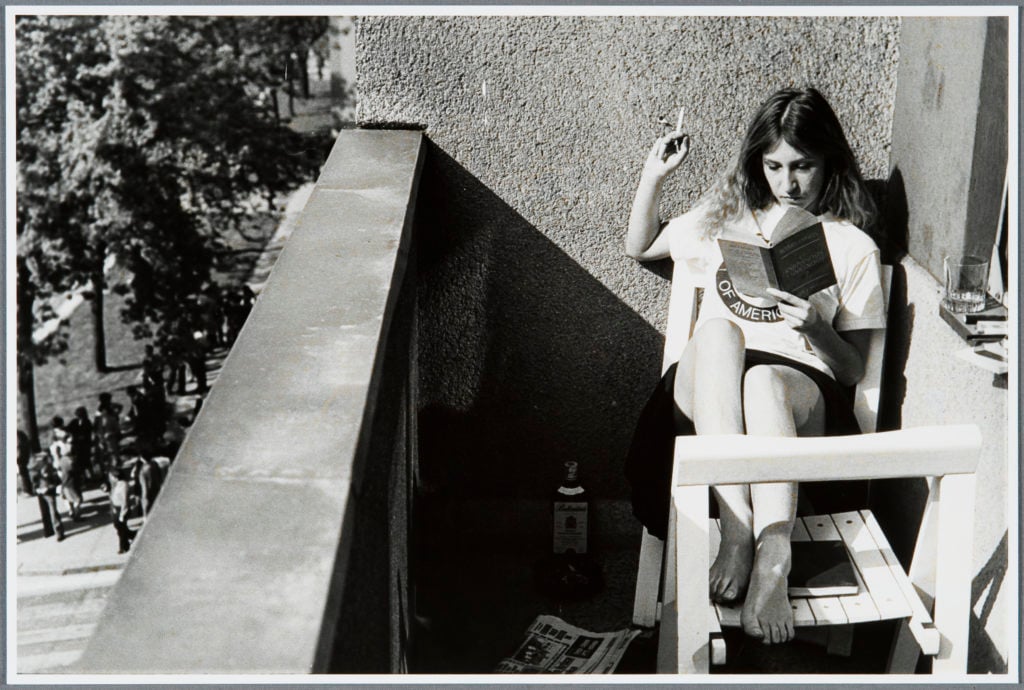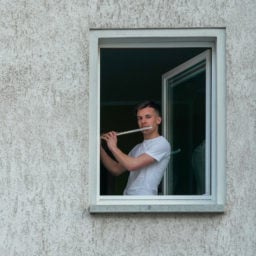As more of the world enters into isolation to protect public health, windows, balconies and building façades have taken on a new role in public life.
Seven international museums including Madrid’s Reina Sofia and the M HKA in Antwerp have tapped into the potential of these externally-facing spaces for artistic expression, commissioning 16 locked-down artists to create artworks for their balconies. The initiative is the first major non-commercial endeavor to arise since countries globally began sheltering-in-place last month.
Called “Artists in Quarantine,” each new project will respond to the present moment. The catalyzing idea was Sanja Iveković’s historic 1979 work called Triangle, in which the Croatian artist carried out an 18-minute public performance on her balcony to protest the communist president Tito’s visit to Zagreb, which was then in Yugoslavia. In the provocative work, Iveković read, drank whisky, and gestured as though she was masturbating until a security official came and ordered her back inside.
The artists who are now in quarantine are invited to respond to the question: “Do such domestic spaces still have the potential to be subversive and make a public statement, as Iveković’s balcony did in the late 1970s?” Their artistic proposals will be published online twice a week for the next two months on Tuesdays and Thursdays.
https://www.instagram.com/p/B_O3LZDl6vX/
The Slovenian artist Maja Smrekar is the first artist whose work is being shared today, April 21. The museums are sharing a piece that Smrekar began on March 19 in collaboration with Urška Lipovž. For weeks, Smrekar has been blasting a 90-second recording of the leftwing anthem “The Internationale,” which the artist says she has co-opted as a hymn for “mobility in times of immobility.” The song plays on a speaker out of her window that faces a government building across the street. The action references a scene from Federico Fellini’s 1973 film Amarcord, in which a gramophone plays the same anthem from a town’s church bell tower. Set in Italy in the 1930s, the gramophone is quickly shot down by fascists.
The artist says that she began the performance in mid-March when the Slovenian government raised top government officials’ salaries by 30 percent while “any solutions of solidarity for all the rest of the civil society have not been solved at all.” The artist plans to continue the action daily until the end of the country’s lockdown.
Included in the line-up is Azerbaijani visual artist and poet Babi Badalov, Johannesburg-based artist Simnikiwe Buhlungu, and New Zealand artist Kate Newby. The full line up includes artists Sanja Iveković, Osman Bozkurt, Ola Hassanain, Siniša Labrović, Rogelio López Cuenca & Elo Vega, Daniela Ortiz, Zeyno Pekünlü, Isidoro Valcárcel Medina, Guy Woueté, Akram Zaatari, and Paweł Żukowski.
The participating museums are all part of an international museum confederation called L’Internationale, which includes the Reina Sofia and M HKA, as well as the Moderna Galerija in Ljubljana, Slovenia; MACBA in Barcelona, Spain; MSN in Warsaw, Poland; SALT in Istanbul and Ankara, Turkey; and Van Abbemuseum in Eindhoven, the Netherlands.









